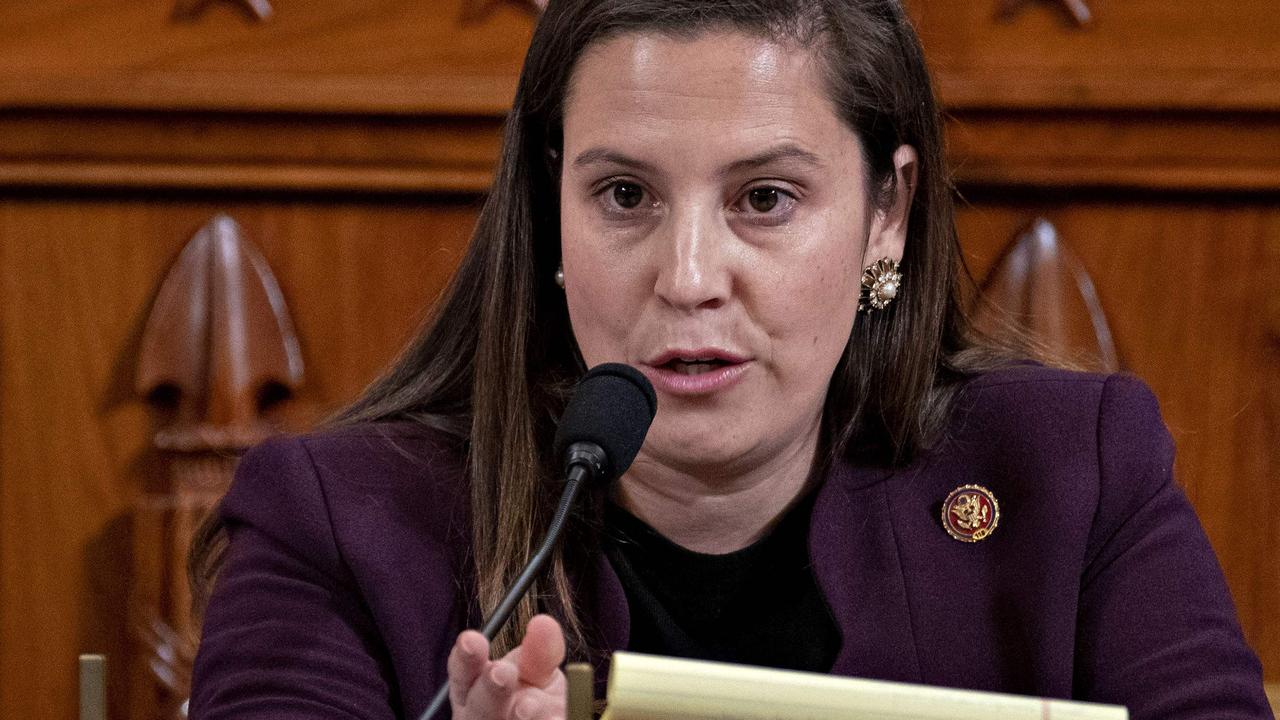Elise Stefanik: Who is the woman replacing Liz Cheney in Republican Party leadership role?
A few years ago, Republican Elise Stefanik was a harsh critic of Donald Trump. Now she is his hand-picked choice to help lead the party.

Two days from now, there will be a significant change in the leadership of America’s Republican Party.
Congresswoman Liz Cheney, who is currently the party’s third-highest ranking member in the House of Representatives, will be punted from her role as conference chair.
Ms Cheney has repeatedly (and very publicly) contradicted former president Donald Trump’s false claims about the 2020 election. And that has made her position untenable.
In a letter to Republican House members today, Minority Leader Kevin McCarthy said he would hold a vote on the matter on Wednesday.
Mr McCarthy said his party’s “driving focus” must be on retaking control of the House in the 2022 midterm elections, and Ms Cheney’s public remarks were distracting from that goal.
“Each day spent relitigating the past is one day less we have to seize the future,” he wrote.
“This is no time to take our eye off the ball. If we are to succeed in stopping the radical Democrat agenda from destroying our country, these internal conflicts need to be resolved so as to not detract from the efforts of our collective team.
“Having heard from so many of you in recent days, it’s clear that we need to make a change. As such, you should anticipate a vote on recalling the conference chair this Wednesday.
“We are a big tent party. We represent Americans of all backgrounds and continue to grow our movement by the day. And unlike the left, we embrace free thought and debate.”
RELATED: ‘She’s gone’: The downfall of Trump’s nemesis

There is no doubt that Ms Cheney will lose her position on Wednesday. Nor is there any real doubt about who will be chosen to replace her as conference chair.
Mr McCarthy, second-ranked Republican Steve Scalise and, most crucially, Mr Trump have all endorsed New York Congresswoman Elise Stefanik for the job.
“The House GOP has a massive opportunity to upgrade this week from warmonger Liz Cheney to gifted communicator Elise Stefanik,” the former president said in a statement on his freshly launched blog today.
“We need someone in leadership who has experience flipping districts from blue to red (Democrat to Republican) as we approach the important 2022 midterms, and that’s Elise! She knows how to win, which is what we need!”
Last week he said Ms Stefanik was “a far superior choice” than Ms Cheney.
Ms Stefanik’s promotion to a leadership position won’t surprise anyone – she has long been seen as a rising star of the party. The circumstances, however, are intriguing.
The woman whose loyalty to Mr Trump is seeing her elevated now was an unapologetic critic of his just a few years ago.
RELATED: ‘Total disgrace’: Trump fumes over Facebook ruling

‘The future of the Republican Party’
Ms Stefanik was elected to Congress in 2014. At the time, she was the youngest woman ever elected, though she would later lose that record to Democrat Alexandria Ocasio-Cortez.
She quickly solidified her reputation as a moderate who was willing to vote across party lines, becoming one of the most bipartisan members of Congress.
Then, in 2015, Mr Trump ran for president. He was the immediate frontrunner for the Republican nomination.
Ms Stefanik never endorsed anyone during the 2016 primaries, and pledged to support the Republican nominee, but her opinion of Mr Trump was not hard to glean.
“I think in the presidential field, there are some candidates who are somewhat disqualifying themselves with untruthful statements,” she said in December 2015.
“Not being willing to really talk about the substance of issues, and just firing away rhetorical devices that don’t necessarily have a basis in fact.”
She was also heavily critical of Mr Trump’s repeated personal attacks on female news anchor Megyn Kelly.
“I think he has been insulting to women,” said Ms Stefanik, also in late 2015.
“I think this may be Mr Trump’s peak moment. And I think we’re going to see his numbers change and decline over the coming weeks and months as the other candidates have an opportunity to share their vision for the future.
“We need to ensure that we’re increasing our party’s ability to reach out to women. And I work on that in Congress. I care passionately about that. And Donald Trump’s comments have not helped that effort, they’ve hurt that effort.”
That was long before the Access Hollywood tape emerged, featuring Mr Trump bragging about grabbing women “by the pussy”.
“Donald Trump’s inappropriate, offensive comments are just wrong, no matter when he said them or whatever the context,” she said in October 2016, after the tape was published.

Ms Stefanik’s criticism of Mr Trump was not just about his rhetoric. She also vehemently opposed some of his most prominent policy ideas.
For example, she came out against his proposal to ban Muslims from entering the US.
“This is not who we are as a country,” she told The Post Star, adding that such a ban would violate America’s “constitutional principle” and there was “no place” for Mr Trump’s stance.
Ms Stefanik also opposed building a wall along the border with Mexico.
“I don’t think that’s realistic,” she said after he took office, having previously bemoaned the politicisation of the border.
She voted for legislation that would have stopped Mr Trump from withdrawing the US from the Paris climate change agreement, and voted against the then-president’s signature tax cut package in 2017.
Overall, Ms Stefanik voted for Mr Trump’s policy positions 78 per cent of the time throughout his term in office – one of the lowest numbers among House Republicans, and far lower than Ms Cheney’s.
She has a lifetime rating of just 35 per cent from the Club for Growth, a conservative organisation which tracks members’ voting records.
As recently as 2019, Ms Stefanik was being showered with praise by moderate Republicans, as well as the mainstream media.
“Elise isn’t just the future of the Republican Party. She is the future of hopeful, aspirational politics in America,” former House speaker Paul Ryan wrote for Time magazine that year, to mark Ms Stefanik’s inclusion on its “100 Next” list.

From critic to loyalist
Ms Stefanik represents New York’s 21st congressional district, and its political evolution has mirrored hers.
In 2012 it voted for Barack Obama over Mitt Romney by a margin of six per cent. Mr Trump won it by 14 per cent four years later, and had no trouble keeping it in 2020.
As her constituents became more pro-Trump, so did she.
If there was a single turning point, it came during the first impeachment of Mr Trump.
Democrats in Congress argued the president had abused his power by withholding military aid from Ukraine in an attempt to pressure the country’s government into investigating his chief political opponent, Joe Biden.
Ms Stefanik became one of Mr Trump’s most vocal and persistent defenders throughout the saga, confronting the Democrats during congressional hearings and using TV appearances to build her national profile.
By the time last year’s election rolled around, she was fully on the bandwagon. While Ms Cheney was contradicting Mr Trump’s conspiracy theories about the election, Ms Stefanik was amplifying them.
“Tens of millions of Americans are rightly concerned that the 2020 election featured unprecedented voting irregularities,” she said on January 4, two days before thousands of Mr Trump’s supporters violently stormed the Capitol.
She signed an amicus brief in support of a lawsuit filed by Texas Attorney-General Ken Paxton, requesting that the Supreme Court throw out the results from four swing states Mr Biden won. The Supreme Court swiftly threw out the case.
Finally on January 6, during the joint session of Congress, Ms Stefanik voted against certifying the election results. Explaining her decision in an open letter to her constituents, she parroted several debunked claims.
For example, she said “more than 140,000 votes” in Georgia’s (Democrat-leaning) Fulton County had come from “underage, deceased and otherwise unauthorised voters”, meaning a quarter of the country’s votes were fraudulent.
This was blatantly false, as Republican election officials in Georgia had repeatedly pointed out. The true number of ballots cast in the name of deceased voters was two.
Ms Stefanik also boosted claims that Georgia’s Republican officials “eliminated voter verification”; that officials in Michigan had illegally counted ballots that were cast too late; and that there were issues with Dominion voting software. All of these were baseless.

Making her move
As the push to oust Ms Cheney gathered steam last week, and Ms Stefanik emerged as the likely replacement, she appeared on the podcast of Steve Bannon, who worked as Mr Trump’s senior political adviser in the White House.
“My vision is to run with support from the president and his coalition of voters, which was the highest number of votes ever won by a Republican in 2020,” Ms Stefanik said.
“This is also about being one team. And I’m committed to being a voice and sending a clear message that we are one team, and that means working with the president and working with all of our excellent Republican members of Congress.”




